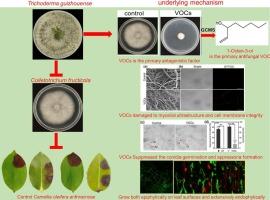Trichoderma guizhouense COTG-19 act as a potential biocontrol agent against Camellia oleifera anthracnose
IF 4
1区 农林科学
Q2 BIOCHEMISTRY & MOLECULAR BIOLOGY
引用次数: 0
Abstract
Camellia oleifera anthracnose (COA) caused by Colletotrichum spp. is a major diseases impeding the sustainable development of C. oleifera in China. Chemical pesticides remain currently the primary control method, while long-term use poses significant risks to human health, environment and fungal resistance. Urgent action is needed to screen eco-friendly biocontrol agents against this disease. In this study, an Trichoderma strain COTG-19 was isolated from the roots of healthy C. oleifera plants, and identified as T. guizhouense combined with morphological and molecular characteristics. In the plate dual cultures assay, COTG-19 exhibited a notable inhibition rate against Colletotrichum strains that ranged from 71.89 % to 83.95 %. In addition, COTG-19 showed a strong preventive and therapeutic effects against COA, as determined with an in vitro leaf evaluation method. COTG-19 could produce chitinase, β-1,3-glucanase, lipase and protease to dissolve cell walls and membranes of pathogen. The volatile organic compounds (VOCs) produced by COTG-19 demonstrated significant inhibitory effects on mycelial growth. Scanning electron microscopy (SEM) and fluorescence microscopy revealed that COTG-19 producing-VOCs caused abnormal changes in mycelial ultrastructure and damaged the cell membrane integrity. Moreover, the VOCs obviously inhibited spore germination and completely blocked appressoria formation of C. fructicola. Using HS-SPME-GC–MS, 22 VOCs were identified, of which six were evaluated for antifungal activity against C. fructicola. 1-Octen-3-ol were identified as the primary antifungal VOCs. In addition, COTG-19 has a fungicide resistance advantage and can extensively endophytically in C. oleifera leaves as well as epiphytically on leaf surfaces, which traits helped sustain the strain's viability when used in nature settings. This study provides valuable insights into the potential application of Trichoderma biocontrol agents against C. oleifera anthracnose, contributing to the sustainable development of the C. oleifera industry.

贵州木霉COTG-19是一种潜在的防治油茶炭疽病的生物制剂
油茶炭疽病(COA)是阻碍油茶可持续发展的主要病害之一。化学农药仍是目前主要的防治方法,但长期使用对人类健康、环境和真菌抗性构成重大风险。需要采取紧急行动,筛选针对该疾病的生态友好型生物防治剂。本研究从油桐健康植株的根中分离到一株木霉COTG-19,结合形态学和分子特征鉴定为贵州木霉。在平板双培养实验中,COTG-19对炭疽病菌的抑制率为71.89% ~ 83.95%。此外,COTG-19对COA具有较强的预防和治疗作用。COTG-19能产生几丁质酶、β-1,3-葡聚糖酶、脂肪酶和蛋白酶,溶解病原菌的细胞壁和细胞膜。COTG-19产生的挥发性有机化合物(VOCs)对菌丝生长有明显的抑制作用。扫描电镜(SEM)和荧光显微镜观察显示,COTG-19产生的vocs引起菌丝超微结构的异常变化,破坏了细胞膜的完整性。此外,挥发性有机化合物还能明显抑制果霉孢子的萌发,完全阻断其附着胞的形成。利用HS-SPME-GC-MS鉴定出22种挥发性有机化合物,其中6种具有抗真菌活性。1-辛烯-3-醇被鉴定为主要的抗真菌VOCs。此外,COTG-19具有抗杀菌剂的优势,可以广泛地在油油树叶片的内生和叶面的附生,这些特性有助于维持菌株在自然环境下的生存能力。本研究为油桐炭疽病木霉生物防治剂的潜在应用提供了有价值的见解,有助于油桐产业的可持续发展。
本文章由计算机程序翻译,如有差异,请以英文原文为准。
求助全文
约1分钟内获得全文
求助全文
来源期刊
CiteScore
7.00
自引率
8.50%
发文量
238
审稿时长
4.2 months
期刊介绍:
Pesticide Biochemistry and Physiology publishes original scientific articles pertaining to the mode of action of plant protection agents such as insecticides, fungicides, herbicides, and similar compounds, including nonlethal pest control agents, biosynthesis of pheromones, hormones, and plant resistance agents. Manuscripts may include a biochemical, physiological, or molecular study for an understanding of comparative toxicology or selective toxicity of both target and nontarget organisms. Particular interest will be given to studies on the molecular biology of pest control, toxicology, and pesticide resistance.
Research Areas Emphasized Include the Biochemistry and Physiology of:
• Comparative toxicity
• Mode of action
• Pathophysiology
• Plant growth regulators
• Resistance
• Other effects of pesticides on both parasites and hosts.

 求助内容:
求助内容: 应助结果提醒方式:
应助结果提醒方式:


